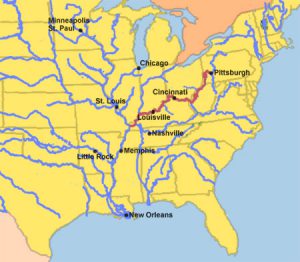Two cities sit on the same river. Their cultures of water, however, are very different. Louisville, Kentucky and Cincinnati, Ohio reveal contrasting marks from their shared Ohio River. This realization occurred to me as I reflected on research for a Walkshop in Louisville and my frequent visits to Cincinnati to see my wife’s family.
The Ohio River in Cincinnati is narrow. Perhaps because of its constricted width, the river is an organic part of the community, a resource that circulates and connects people. Numerous bridges span the river, allowing both pedestrian and vehicular traffic to cross with ease. People use the river as a name for some of the places where they congregate; Riverfront Stadium and Newport-on-the-Levee are just two of many examples. For generations, the river has helped the movement of people and goods. The city matured as a depot.
Louisville’s Ohio River is different. There, the river is wide. It is more of barrier than a connector. The width of the river meant the sides were more shores than banks, more like the edges of two separate land masses. In addition, the river’s most defining feature here is the impediment to movement–the Falls of the Ohio. The Falls forced people to shore to calculate their next move. The river was thus a factor to be overcome, a complication to the flow of things and the point of an extra cost for a solution. Intriguingly, while the river still made an impression on people, the imprint was in sight and not in name. Scenes of flowing water mark the downtown, with numerous fountains and formal pools of water.
Sharing a resource or asset is not the duplication of that resource or asset. The same thing can have significant differences in one setting or situation as compared to the next. You will need to account for those differences. They should be reflected in your planning, your methods, your approach, your strategy, your expectations.








